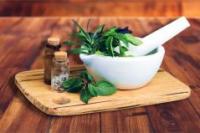Botanical Family: Lamiacea or Labiatae (mint)
Plant Origin: India, Utah, France
Extraction Method: Steam distilled from leaves, stems, and flowers
Key Constituents: Methylchavicol (estragol) (40-80%), Linalol (10-50%), 1,8-Ceneole (1-7%), Eugenol (1-10%)
ORAC: 54,000 mTE/100g
Historical Data: Used extensively in traditional Asian Indian medicine, basil’s name is derived from “basileum”, the Greek name for king. In the 16 century, the powered leaves were inhaled to treat migraines and chest infections. The Hindu people put basil springs on the chests of the dead to protect them from evil spirits. Italian women wore basil to attract possible suitors. It was listed in Hildegard’s Medicine, a compilation of early German medicines by highly regarded Benedictine herbalist Hildegard of Bingen (1098-1179)
Medical Properties: Powerful antispasmodic, antiviral, antibacterial, anti-inflammatory, muscle relaxant
USES: Migraines, throat/lung infections, insect bites.
Fragrant Influence: Fights mental fatigue.
Application: Dietary supplement; Dilute 1 part essential oils with 4 parts V-6 Vegetable Oil Complex or other pure vegetable oil; (1) apply 2-4 drops on location, temples, neck, (2) apply on chakras and /or Vita Flex points (crown of head, forehead, heart, and navel), (3) inhale directly, (4) diffuse, or (5) take as dietary supplement.
|
|

